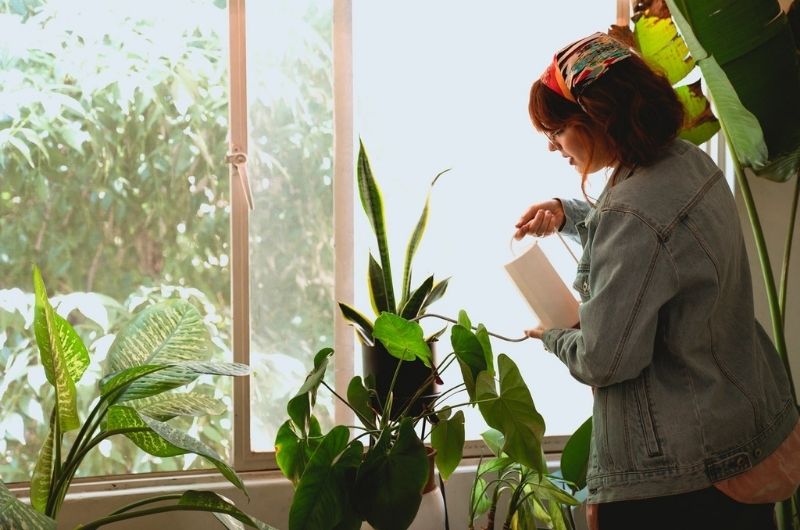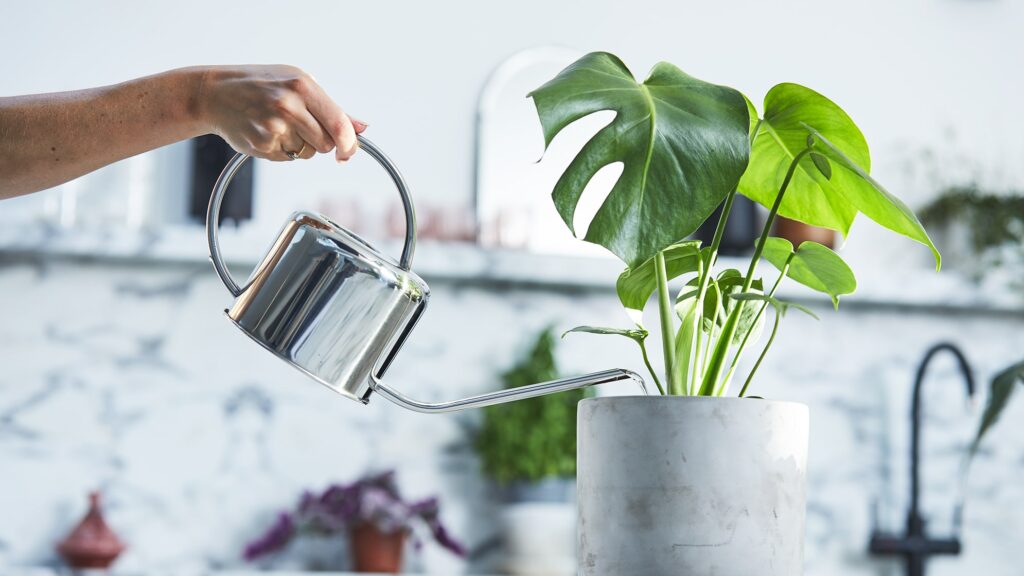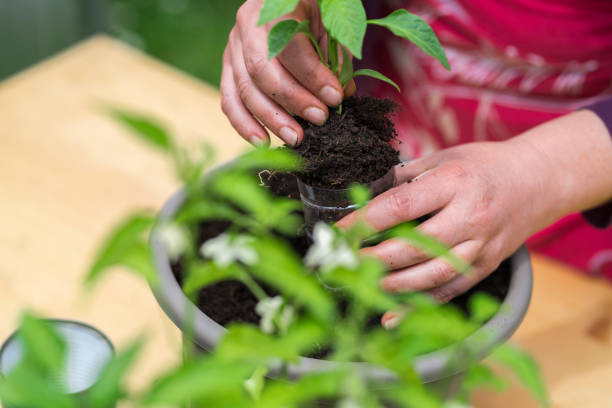Watering indoor plants might sound simple, but for beginners, it’s often one of the trickiest parts of plant care. How much water should you give? How often? The truth is, there’s no single answer. It depends on the plant type, pot size, climate, and even where you place the plant in your home.
When I started keeping indoor plants, I believed watering them every day would keep them happy. But I quickly learned that too much water can be just as harmful as too little. Over time, I made plenty of mistakes, learned from experience, and discovered what works best. In this beginner-friendly guide, I’ll walk you through everything I’ve learned about how to water indoor plants properly, using practical tips based on real experience.

Why Watering Matters More Than You Think
Water plays a crucial role in a plant’s health, but it’s also where most new plant owners slip up. If you water too much, the roots can drown. If you water too little, the plant dries out. Learning the balance is key to keeping your indoor garden green and thriving.
I learned that proper watering can make the difference between a plant that flourishes and one that slowly fades. Once you understand how to observe your plant’s needs and adjust your watering habits accordingly, everything becomes much easier.

How Often Should You Water Indoor Plants?
This is one of the most common questions beginners ask. Unfortunately, the answer isn’t the same for every plant. Some need to be watered once a week, while others can go two weeks or more without needing a drop. Many factors affect watering frequency, such as humidity, pot size, soil type, and the season.
Personally, I stopped following a fixed watering schedule. Instead, I started checking the soil regularly. If the top inch feels dry, that’s when I water. If it still feels moist, I will wait another day or two. This habit helped me avoid both overwatering and underwatering.
Over time, I noticed that my succulents preferred dry soil and needed watering every 10 to 14 days. My peace lilies, on the other hand, wanted their soil to stay slightly moist, so I watered them more often. Observing your plants is always more effective than sticking to a calendar.
If you’re wondering how often to water different types of plants, check out this detailed guide by plant type for more specific watering schedules.
Lessons Learned: Why Indoor Plants Struggle
When I began growing indoor plants, I faced a lot of setbacks. Some plants wilted, others turned yellow, and a few just stopped growing altogether. I thought something was wrong with the light, the soil, or even the pot. But in many cases, the real issue was how I was watering them.
Overwatering
One of my biggest early mistakes was giving plants too much water. I thought I was helping, but I was actually drowning the roots. The soil stayed soggy for too long, leading to root rot. Now I always check the soil first and make sure there’s proper drainage. Make sure your pots have proper drainage. Here’s a helpful article on why drainage holes are essential for indoor plants.
Underwatering
There were also times when I completely forgot to water my plants. Their leaves would dry out, become crispy, and droop. This reminded me how important it is to stay consistent. Even low-maintenance plants need attention.
Light-Related Problems
Watering and lighting go hand in hand. In the beginning, I placed some of my plants in harsh, direct sunlight. Their leaves developed brown spots. Others were in dark corners and barely grew. Once I started pairing the right amount of light with the right watering schedule, my plants began to bounce back.
Pot and Soil Issues
I didn’t know much about pots at first. Some were too small, causing the soil to dry out quickly. Others were too large, leading to soggy conditions. I also used regular garden soil, which didn’t drain well. Switching to well-draining indoor potting mix helped a lot.
Pests and Temperature Swings
Stressed plants attract pests. At one point, I noticed small bugs crawling on the leaves. That’s when I realized that poor watering habits and temperature changes were weakening my plants. Since then, I’ve kept my plants away from heaters, air conditioners, and drafty windows.
What I Consider Before Watering My Plants
Before watering, I ask myself a few simple questions. These small steps make a big difference and help me avoid common watering mistakes.
First, I check the soil. I press my finger about an inch deep. If it feels dry, I water the plant. If it’s still damp, I wait. I also use room-temperature water because cold water can shock the roots, while hot water can cause damage.
I always water in the morning or early afternoon. This gives the plant time to absorb moisture before nighttime, when temperatures drop. And most importantly, I make sure every pot has good drainage. Water should never sit at the bottom of a pot, because it can lead to root rot.
How I Water Indoor Plants the Right Way
Over time, I’ve created my own system for watering plants properly, based on observation, trial, and patience.
I start by checking the soil, either with my finger or a moisture meter. If the soil is dry, I pour water slowly and evenly around the base of the plant. I continue until a small amount of water drains from the bottom of the pot. This tells me that the roots have received enough water.
I avoid pouring water directly on the leaves. Wet leaves can attract mold and disease. If the leaves are dusty, I gently wipe them with a soft cloth instead of spraying them.
After watering, I always empty the tray beneath the pot. Standing water can lead to fungal growth and root rot. Each plant has different needs, so I pay close attention to how they respond and adjust my watering routine accordingly.
Some plants like to be watered from the bottom. I do this by placing the pot in a shallow tray of water and letting it soak for 20 to 30 minutes. Once the soil feels moist at the top, I remove the pot and let it drain completely.

Helpful Tools That Make Watering Easier
Having the right tools has made a big difference in how I care for my plants. A watering can with a long, narrow spout lets me pour water exactly where I want it without spilling on the leaves or the floor.
I also use self-watering pots for a few of my plants. These are especially helpful when life gets busy or I forget to water on time. When I travel, I rely on indoor watering systems or water globes to keep my plants hydrated while I’m away.
Watering Indoor Plants While on Vacation
Going on vacation doesn’t mean your plants have to suffer. Before leaving, I water all my plants thoroughly and move them away from direct sunlight to reduce their water needs.
For longer trips, I use self-watering devices or set up a simple drip system with a water bottle. These methods can keep the soil moist for up to two weeks. If I’m gone longer, I ask a friend or neighbor to check in and give the plants a quick water if needed.
For hassle-free care during trips, you can use any of these beginner-friendly self-watering pots.

Conclusion
Learning how to water indoor plants takes time, observation, and a little patience. It’s not just about pouring water into the soil. You need to consider the type of plant, the weather, the pot, and your home’s environment.
The good news is, once you understand your plant’s unique needs and develop a regular routine, it becomes an enjoyable part of your day. Watering your plants can be a peaceful, rewarding experience—and seeing them thrive is well worth the effort.
Want to dive deeper? Explore more watering tips to better understand your indoor plant’s needs.
FAQ
- How to water indoor plants while away
You can use self-watering planters or a plant sitter. Another option is to water them well before leaving. - How to water indoor plants when away for a month
You can use a drip irrigation system or water globes. Make sure the plants are well-watered before you leave. - How to water indoor plants while on vacation for 3 weeks
Consider placing your plants in a shallow water tray. You can also use a friend or neighbor to water them. - How to water indoor plants in winter
Water your plants less often in winter. Ensure the soil dries out between waterings. - How to water indoor plants properly
Water the soil, not the leaves. Always let the water drain freely from the pot. - How to water indoor plants while on vacation
Use a self-watering device or place plants in a cool spot. Ensure they get indirect sunlight while you’re away. - How to water indoor plants from the bottom
Fill a tray with water and let the plant absorb it. Ensure the pot has drainage holes to avoid overwatering. - How Often to Water Indoor Plants
Make sure the plants have enough moisture every day. Water your plants whenever it’s dry.


